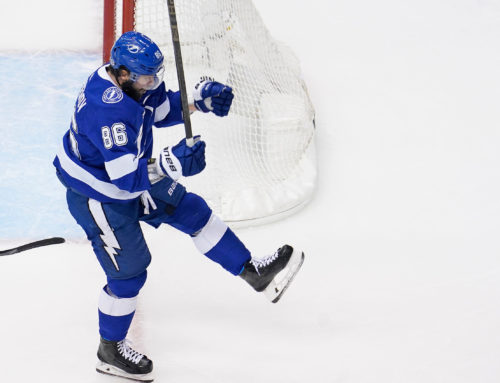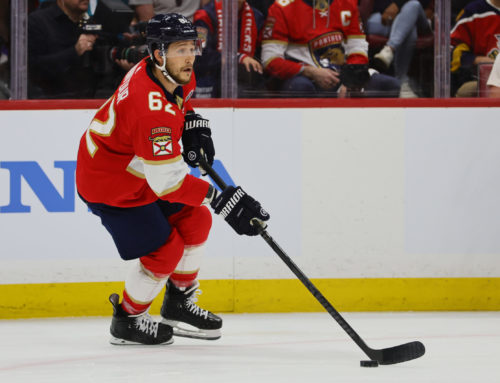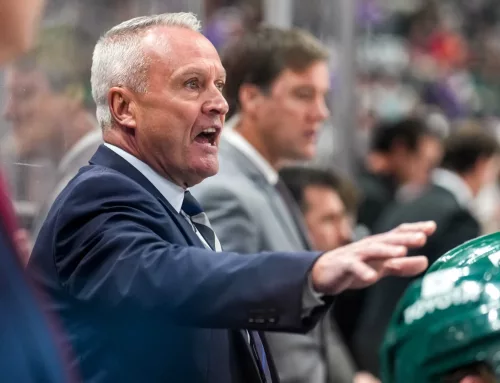Ramblings: Holtby; Meier; Point; Orlov; Morrissey; Baseline Production – May 25
Michael Clifford
2018-05-25

Now that we have a few days off until the Stanley Cup Final – it’s still sinking in that we have a Vegas-Washington matchup – it’s probably a good time to go through some playoff performances.
*
If there were any doubt that Brayden Point played over his head during his sophomore year, all those doubts should have been laid to rest. He had 16 points in 17 games and though the shooting percentage was high, he’s posted a high number for his short career so far. He was easily the most dangerous forward for the Lightning all through the Washington series and he and Ondrej Palat played very well together throughout the playoffs when given ice time together. It was nice to see him get consistent top power-play minutes towards the end of the team’s run as well. If he can stay on that top PP unit next year, this is a point-per-game player in the making.
*
Though the physical play of Dustin Byfuglien got the headlines for the Jets blue line, it was Josh Morrissey who appeared very involved in the offence. Just two points in 16 games won’t draw praise but he seemed aggressive with his pinching and jumping into the play. He should be a 30-point defenceman next year with solid peripherals, making him a nice target in multi-category leagues.
*
Timo Meier had one of the highest shot rates in these playoffs among all forwards and led Sharks in this regard at five-on-five. The news about Evander Kane’s signing will draw the attention, but this really rests on the future of Joe Thornton. In my head, I envision Kane/Pavelski as the top line, Couture with Hertl on the second line, and Thornton feeding Meier on the third line in a sheltered role. That’s my vision, I’m sure the coach would have other plans. Should Thornton come back, I will be drafting Meier everywhere I can. That’s an if, though, because with Hertl, Kane, Donskoi, and others in the mix, it might not mean consistent top-6 minutes for Meier.
*
It’s worth noting Dmitry Orlov averaged two shots, two hits, and two blocked shots a game through the first three rounds despite not cracking any of those benchmarks in the regular season. John Carlson’s future is uncertain with the team and it seems like the cap-strapped team might have to let him walk. The top PP unit has been built around a right-handed defenceman who can feed Alex Ovechkin going back to the Mike Green days. Orlov is a lefty. Do they change the PP around to accommodate him or just slide Matt Niskanen to that spot? I hope it’s Orlov and they figure out a way to make it work. It would easily push him over the 40-point plateau for the first time in his career.
*
I wonder what this Cup run has done for Braden Holtby’s ADP next year? He burned everyone who drafted him for the 2017-18 season and eventually lost the starter’s job to Philipp Grubauer. In an alternate universe, Grubauer and the Caps get bounced in the first round and we have a Holtby who lost the starter’s job and couldn’t even get in the cage for the postseason. Instead we have a Holtby who took the job back, helped the Caps come back against the Blue Jackets, posted a .924 save percentage through three rounds, and shutout the Lightning in back-to-back games to get to Washington’s first Cup Final in the Alex Ovechkin era.
He’s probably a top-10 goalie off the board again, yeah?
*
Had to laugh at this: I missed it, but Eeli Tolvanen didn’t win rookie of the year in the KHL, as pointed out in a recent Prospect Ramblings. I get why it happened, but it’s still hilarious nonetheless.
*
Over my last several Ramblings, there have been a variety of topics discussed like shot distribution of forwards and defencemen at five-on-five, changes in shot rates, changes in goal-scoring from defencemen, and a few others. Just check back through the archives for these articles or click through the links posted in yesterday’s Ramblings.
One topic I wanted to dive into was fantasy-relevant outputs like goals, assists, and shots. If goal-scoring is going up, it likely means assist totals are going up. We’ve already established in prior Ramblings that shots are increasing, so what was useful for fantasy production two years ago is not relevant anymore.
For that reason, let’s go through what exactly are fantasy-relevant numbers now. For today, just goals, assists, and shots on goal will be discussed. Other stats like penalty minutes, hits, and blocks will be discussed at a later date.
First, the calculations. To do this, assumptions need to be made. Not every league is the same; some are 8 teams, some are 20, and everything in between. All roster sizes aren’t the same; some have three defencemen, some have five, some have eight. Some have 14 forwards, some have 10. The flexibility of fantasy hockey leagues can be a wonderful thing for variety… and a nightmare for broad analysis.
With that said, here are the assumptions I’m making:
- 12-team leagues with 22-man rosters including goalies
- Ten forwards, five defencemen in the starting lineup
- Three forwards, one defenceman on the bench.
We are going to set aside positions for now (position-specific rankings at a later date as well). That gives us a pool of 156 forwards and 72 defencemen. The cut-off was made specifically at those numbers, which means ties were not included.
This is what it looks like and it’s for all strengths.
Forwards
Goals
The top 156 forwards in goal scoring this past season tallied 3888 goals which gives us an average of 24.9 goals per forward. For a reference, the top 156 forwards in goal scoring in 2016-17 tallied an average of 22.8 goals per forward. When I said in a Ramblings recently that the rise in goals meant the phrase “20-goal scorer” just doesn’t mean the same as in recent seasons, that’s why. When fantasy-relevant players are scoring more, the guys scoring that common benchmark total just don’t pack the same value. The standard deviation was 7.1 so to be considered among the top-end scorers, we should expect 32 goals and the truly elite should border 40.
Assists
With the rise in goals we should expect a rise in assists. That, of course, happened as the top 156 forwards in 2016-17 combined for 4979 assists and that increased to 5523 assists in 2017-18. That gives us an average of 35.4 assists for fantasy-relevant forwards, up from the 31.9 in 2016-17. For reference on what that means on the total number of players available to hit those marks, only 54 forwards managed at least 35 assists in 2016-17 but 66 managed 35 helpers in 2017-18. The standard deviation was 11.8, so the upper-tier of assist contributors should have 47 assists with the absolute elite at around 59. Again for a reference, just two players had at least 59 assists in 2016-17 but nine managed that many last season.
I think the most common benchmark for assists among fantasy owners is 30 but that is sorely misguided.
Shots
When it comes to shots, there’s a reason why 200-shot players aren’t a huge deal anymore. The 2017-18 season saw 31 391 shots on goal from the top 156 shot-takers, giving us an average of 201.2 shots on goal. That’s right: the average fantasy-relevant forward with the parameters given averaged over 200 shots on goal. For reference, the top-156 shot-on-goal forwards in 2016-17 managed an average of 190.3. The average fantasy-relevant forward saw an increase of over 10 shots on goal over the course of the season. The standard deviation was 41.2, which means upper-tier shot-on-goal forwards should have over 240 shots and the elite should be over 280.
Defencemen
Goals
This is where things deviate from what the forwards have seen for production changes, goal-scoring by defencemen. In 2017-18, the top 72 rearguards scored 667 goals with the prior season seeing 668. The average goal output has thus stayed constant at 9.3 tallies. Because there weren’t as many high-end goal scorers – the league leaders were at 17 while Brent Burns nearly cracked 30 the year prior – our standard deviation was lower, dropping by about a third of a goal to 3.8.
Goal-scoring is an area where I’m not sure what the future holds for defencemen. This past campaign was the first time since the lockout that any blue liner failed to crack 20 goals but we had 13 such instances over the four seasons from 2013-17. Is it a single-season aberration or will myriad factors continue to suppress top-tier goal-scoring from defencemen?
Assists
Like forwards, we saw a rise in total assists from blue liners, both totals and averages. There were 2101 total assists from the top 72 defencemen in helpers in 2016-17 but that number rose to 2225 in 2017-18. That pushed the average output up to 30.9 assists from 29.2. It also pushed the standard deviation from 8.4 to 10.7. In other words, we had a lot of top-end assist totals from rearguards, meaning the top-end fantasy-relevant defencemen in this category had over 50 assists, a mark only two guys cracked in 2016-17. The new benchmark for assists from defencemen is 30, which had been, as mentioned before, the old benchmark for forwards. The times, they are a-changin’.
Shots
Again, like forwards, we saw a bump in shots. It’s not a small bump, either, this thing is like the overeater from Monty Python’s Meaning Of Life: 2017-18 saw the average fantasy-relevant defenceman put up 173.1 shots on goal compared to just 158 in 2016-17. A 10 percent(ish) increase is nothing to overlook. The standard deviation was 40.3, meaning if you’re looking for upper-tier shot production from a blue liner, start north of 210 shots on goal. That is a lot of shots.
Just to summarize what this has shown, this is what the average fantasy-relevant forward produced last year (numbers rounded): 25 goals, 35 assists, and 201 shots on goal. Per Hockey Reference, just 24 forwards hit all three marks last season. That’s how hard it is for a player to be average in three major fantasy hockey categories; there were fewer than one forward per NHL team to have done so.
For defencemen, the averages were 9 goals, 31 assists, and 173 shots. Again from Hockey Reference, we have just 15 blue liners to hit all three of those targets last year and the only guy that was a real surprise was Colin Miller.
These are our baselines for fantasy-relevant players given our parameters. Please keep in mind that the averages and standard deviations will change, perhaps considerably, in 10-team or 16-team leagues, and leagues with deeper rosters. This is just to give fantasy owners in standard leagues a guideline on what to look for in 2018-19.





 BUF
BUF N.J
N.J PHI
PHI MIN
MIN VAN
VAN FLA
FLA TOR
TOR CGY
CGY ANA
ANA